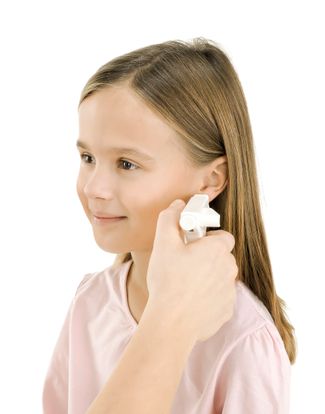Medical Ear Piercing

We use a medical grade system available only through medical professionals. Our earrings are not regular earrings. The earrings are specially designed for optimal healing. The piercings are housed in single use sterile cassettes, reducing the risk of infection and transmission of disease between patients. And all materials are made of medical grade plastics and titanium. This allows those with nickel and other contact allergies to comfortably wear earring
Frequently Asked Questions:
Why choose Medical Ear Piercing?
Traditional ear piercing guns present a genuine health hazard. They can easily transmit blood-borne viruses. The danger is so real that most European countries have banned these instruments. Unfortunately, they are still legal and widely available in the USA. We use single-use, disposable cassettes that eliminate the chance of transmission.
How does Medical Piercing work?
Sterile Single Use Products: First, where you want your jewelry is marked and the skin is thoroughly cleansed. The piercing is then done with the sterile jewelry that is pre-mounted in a sterile disposable holder. The parts that touch you directly come from the sterile packaging, without touching anybody else.
"Modern Aseptic Technique"
Our medical piercing system is built on this premise. This means that our products and methods are safely designed in order to avoid the spreading of infections when piercing. The types of iinfections one wants to avoid are caused by bacteria, such as MRSA, and blood-borne viruses, such as hepatitis B.
Does it hurt?
No. Yes. A little. All of us feel differently when it's done. Pain may feel similar to receiving a vaccine. Directly after, the piercing site may feel a little warm and tender, but that quickly fades away. We also numb the area to be pierced with a topical cream prior to piercing to make the process as painless as we can.
Simultaneous Piercing
The best way for children: Even when children really look forward to having their ears pierced, sometimes they change their mind after the first hole is done. We recommend simultaneous piercing to make it faster and make the child feel safer.
What about allergic reactions to my earrings?
Nickel is commonly used as a metal hardener and most metals used for ear piercing contain nickel. Nickel is one of the most common causes of allergic contact dermatitis. Allergic contact dermatitis is an itchy rash that occurs when your skin comes in contact with a typically harmless substance. Fresh piercings allow direct and constant contact between a minor open wound and the metal, which contains nickel. Our system uses medical grade plastic and titanium in order to avoid nickel exposure during the ear piercing healing process and decrease the risk of allergy or reaction.
How do I care for the piercing during the healing period?
Keep it clean and dry. Cleanse it thoroughly twice a day with liquid soap and water or with Piercing Aftercare cleansing swabs. If it's still damp after cleansing, dry with a Q-tip. Apart from that you should not touch the jewelry or the piercing while it's healing. Be careful with hairspray, clothes and other things that can contaminate and irritate.
Keep it airy. In order to keep it clean and dry, air must circulate around the piercing. We have specifically designed piercing jewelry. For example, with ear piercing, the earring back always sits on the furthest tip of the ear stud covering the sharp point completely, but allowing air to circulate freely around the wound. Unlike conventional ear piercings, there is no need to rotate or twist the medical grade studs to prevent them from adhering to the skin.
When piercing, you receive comprehensive, written aftercare instructions.
How long do I keep the studs in place?
We recommend waiting at least 6 weeks before changing earrings in the lobe of the ear, 12 weeks for cartilage, and 4 weeks for nose piercings. The piercing studs we use are a little thicker (1.3 mm) than the standard earring post (1.0 mm). This creates a larger piercing hole which makes it easier to switch to normal earrings after the healing period and reduces the risk of repeatedly reinjuring the piercing site when changing earrings, which should therefore reduce the risk of piercing site infection.
Do I need an appointment?
We prefer that you make an appointment for your piercing to minimize any time that you might have to wait.
What areas of the ears and nose may be pierced?
Ear - We can pierce anywhere on the outer ear.
